The best levels, maps, and locations 2018
Let's go sightseeing.
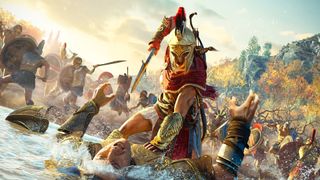
This year we've been to ancient Greece, the 1940s, New York City, a rural fever dream reimagining of the UK, several boats, and the Moon, of course. 2018's games have spoiled us with vivid new worlds to explore, so we decided to round up the smartest and prettiest places we've visited this year in a feature we like to call 'The best levels, maps, and locations 2018'. Let's start with...
Miami, Hitman 2
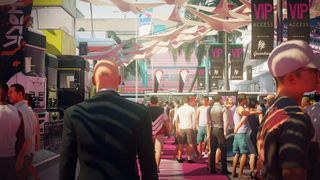
I've spent the most time in Miami from Hitman 2 so far, optimising my route through the level to knock my pals off the leaderboard (it's pretty much the only level where I've managed to do this). It's a gorgeous sprawl, and like Paris from Hitman 2016, you're playing it in the midst of a live event—a formula one race. It's a touch easier than most of the other Hitman levels, but it's among the nicest spaces to spend time in. In completing every mission story, I operated a food truck, set some fireworks to kill, told a robot to murder a guy for me, sabotaged a car, and pushed one target off a roof onto the other. I also killed Sean Bean in a toilet in Miami. Good times. Hitman is the greatest. —Samuel Roberts
Twisted Steel, Battlefield 5
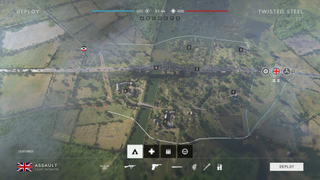
I’m not afraid to admit that, when it comes to multiplayer maps, I love a gimmick. Whether it’s the symmetrical towers of Facing Worlds or the bridge connecting the two bases in 2Fort, I always enjoy a map built around an idea like this. So this is perhaps the main reason why I love Twisted Steel, an enormous map featured in Battlefield V, so much.
Set in war-torn France, this swampy expanse is dominated by an enormous bridge—part of which has dramatically collapsed. Below the bridge is a dense, marshy forest for skirmishing in, but it’s on the structure itself where the most exciting firefights inevitably take place, around the two capture points placed strategically at either end of it.
When the enemy has control of the bridge, wrestling it back from them is a really satisfying challenge. Its elevated position gives snipers a great vantage point on the swamp and scattered buildings below, but the bridge itself is strewn with rubble and wrecks, providing just enough cover to push through and claw it back. —Andy Kelly
The Moon, Prey: Mooncrash
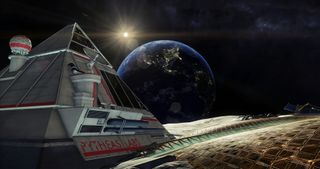
I think I spent more time on Prey's version of the Moon than many real-world places I actually like this year. This unusual roguelike expansion tasks you with finishing the game in multiple ways, ending at different places with a specific character. It's a surprisingly huge space—but it's clever in the small ways it changes between resets of the game. A staircase you needed might vanish, meaning you need to find a new way up. The enemy types will change depending on how high the alien threat level is. That door to the tram that was real handy in your last playthrough? It's on fire now. Across all of its games from both studios, Arkane build world class environments—Mooncrash is imperfect and slightly too gruelling to be as fun as the main game, but it allows the designers to play with the parameters of the level in fascinating ways. —Samuel Roberts
Righteous Stand, Warhammer: Vermintide 2

I've picked the opening to Vermintide 2 partly because it's the level I've spent the most time in from the game so far—mostly because the game was so damn hard when it launched, we had to grind at it over and over again (Fatshark later patched it to be a lot kinder). Compared to the first game's rote objectives and repetitive spaces, though, playing this with the PC Gamer crew was quite the experience: this sprawling city offers quite the view, as well as a number of huge-feeling set pieces. An early nervous encounter in a courtyard is particularly dramatic, since it's the first time you're swarmed from all sides in the game. And the finale—slowly waiting for your exit to emerge from the ground in a big castle while being attacked by rats from every possible angle—feels bigger than anything in the first game. Although, reading that last sentence back, I could pretty much be describing any Vermintide level, there. —Samuel Roberts
The biggest gaming news, reviews and hardware deals
Keep up to date with the most important stories and the best deals, as picked by the PC Gamer team.
Fort Deadlight, Pillars of Eternity 2: Deadfire

When charismatic orlan pirate Serafen joins your crew in Deafire, he reveals the location of a pirate leader who you have a special interest in killing: a criminal hangout called Fort Deadlight. And it’s here where the game’s best quest takes place. If you’re feeling brave you can fight your way through the fort, but it’s much more fun to slip in undetected and blend in with the other pirates there. Talking to them reveals clues about your target’s routine, his weaknesses, and suddenly you’re playing a Hitman level.
There are numerous ways to locate and kill him, and the sprawling, maze-like fort is filled with alternate routes, hidden paths, and NPCs. It’s a brilliantly designed quest, and the location itself is wonderfully vast and intricate. It’s proof that a game doesn’t have to be in three dimensions to create an interesting play space. And the sheer number of ways to complete the quest make for some superb role-playing, including hiring some prisoners to steal your target’s prize ship right from under his nose. —Andy Kelly
The Obra Dinn, Return of the Obra Dinn

This is probably the smallest location on our list, but one of the richest and most powerfully immersive. As you explore this stricken merchant ship a storied past begins to emerge, painting a vivid picture of both everyday life, and the horrors that befell it. The fact that we see the mundane day-to-day activities of the crew makes the moments when tentacles start flailing, flintlocks start firing, and people start dying even more impactful.
Even with that gorgeous 1-bit art style, the ship is remarkably detailed. It’s all in the animation and sound: the creak of the wood, waves lapping at the hull, gas lamps rocking in the wind. The ship feels alive, despite the fact that absolutely everyone is dead. And the more secrets you uncover with your magical pocket watch, the darker your presence there begins to feel. More videogames set on ships, please. —Andy Kelly
Temple of Aphrodite, Assassin's Creed Odyssey
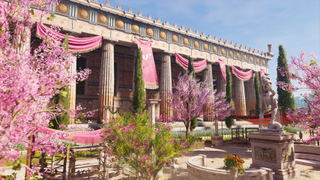
Although the settings in the Assassin’s Creed series have always been romanticised and exaggerated to a point, Odyssey is Ubisoft’s most dramatic and imaginative departure from historical accuracy yet. This is not the ancient Greece of the history books, but of myths and legends. It almost feels like a fantasy setting in places, with towering statues of the gods dominating the skyline and temples perched atop impossibly high mountains. One of which, in the Korinthia region, is the magnificent, colourful Temple of Aphrodite.
Appropriately enough for Aphrodite, the goddess of love and beauty, this is one of the prettiest locations in the whole game. Her grand temple is draped in vibrant pink tapestries, the walls are covered in lavish, dramatic murals, and gleaming white marble statues line the streets around it. It’s the mythical ancient Greece you imagine when you read stories about the era, and I was more than a little awestruck when I stumbled into the temple complex by accident while exploring the map aimlessly on my horse. —Andy Kelly
The Dreaming City, Destiny 2
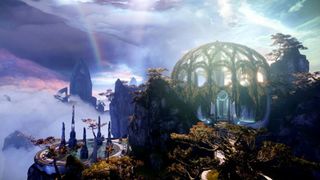
Why were the Awoken slumming it on the Reef when they had this beautiful rainbow palace hidden away all along? Destiny 2: Forsaken’s endgame zone is designed to provide shifting challenges across a month. Secret dungeons move around week to week, and you can hop through dimensional portals to slip between two instances of the zone.
The dreaming part of the city looks like an alien heaven—it’s all marble plazas, glittering interiors, and spinning orreries. The nightmare part feels abandoned and apocalyptic, and overrun by the dark spheres that characterise Taken infestation. The Hive are there too, somehow, burrowing into the mountains to perform their rituals. The Dreaming City doesn’t feel as dangerous or weird as the Hive Dreadnought, but it’s one of the prettiest locations in all of Destiny and Destiny 2—and that’s really saying something. Bungie is so good at awe-inspiring space stuff, and along with the underused Titan Arcology, this is some of the team’s finest work. —Tom Senior
Japan, Yakuza 0
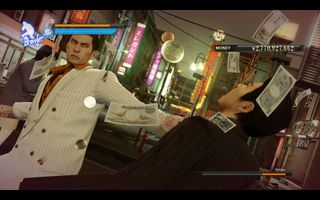
The weird, brilliant Yakuza series has finally punched its way to PC, and this prequel features two beautiful, atmospheric slices of Japanese cities to explore: Kamurocho in Tokyo and Sotenbori in Osaka. Based on Kabukichō in Tokyo and Dotonbori in Osaka, both perfectly capture the feeling of being in a busy Japanese city, and the 1980s setting is brilliantly fleshed out with era-appropriate tech and fashion.
It’s the neon signs, and the /density/ of them, that catch the eye. Both cities are incredibly busy, cluttered, and packed with incidental details, with glowing, colourful advertisements seemingly filling every inch of the screen. But beyond the visuals, this setting is absolutely heaving with weird, interesting, and often slightly disturbing individuals to meet and complete quests for. It’s a compelling and hilarious caricature of ‘80s Japan. —Andy Kelly
Yokosuka, Shenmue I and II

From the bustling Dobuita high street to the sleepy suburbs of Sakuragaoka, Shenmue’s slice of 1980s Japan is one of my favourite videogame settings of all time. And I was glad to see the remaster stick faithfully to the original game’s art style, only boosting the resolution and adding a few tasteful bloom lighting effects. Because despite the relatively simple geometry, the atmosphere of this place is incredible—especially when winter sets in and the snow starts to fall, piling up on the streets, painting the streets white.
It’s more than just the lighting, ambient sound design, and grounded architecture that draw you into this world—the routines of its citizens do too. The more you play, the more the place starts to feel like home. You know that, if you walk past Funny Bear Burger in the afternoon, you’ll see Ryuji Tatsumi from the thrift store eating his lunch. It creates a sense of place, of community, that few games can boast. And also the sensation that this is a world that exists and operates whether you’re there to see it or not. —Andy Kelly
The Coral Highlands, Monster Hunter: World

It’s hard to separate Monster Hunter’s levels from the creatures that live there. When I think of the Coral Highlands the first image that springs to mind is a giant inflating bat. The sacred furry wyvern Paolumu is perfectly at home among the pink coral fronds. As it inflates in self defence, it starts floating around and bumping into things like a panicked bubble. When you track it back to its lair there’s a long convenient vine dangling in the centre of the arena. I dutifully climbed it and secured a jump attack onto the bat’s back for a mean kill.
The game’s most pleasant monsters come to live in the Coral Highlands. The zone is heavily tiered. In the lower areas you find cool little dinos like the Tzitzi-Ya-Ku, with its flashing mantle. In the upper reaches Legiana has its eyrie. Hunting the glorious ice dragon feels like murdering a Swan, but that’s the Coral Highlands for you. You’re a vandal in a pristine slice of paradise. Enjoy it while you can, because after this it’s the Rotten Vale, and that place is full of total bastards. —Tom Senior
Oregon, American Truck Simulator

After the dry, dusty deserts of Nevada, New Mexico, and Arizona, Oregon is a breath of fresh mountain air. This expansion for SCS’ latest trucking sim adds the Beaver State to the map, giving you the opportunity to haul heavy cargo through pine forests, mountain trails, and sleepy rural towns. It’s one of the Czech developer’s finest creations to date, showing just how far its world-building has developed over the last few years.
My heart still belongs to Euro Truck Simulator 2, but this is an exciting glimpse at the variety of terrain we might get to experience down the line. ETS2 has grown massively since release, adding Scandinavia, Eastern Europe, and parts of Russia, so I wouldn’t be surprised to see this map take a similar route. I’m still dreaming of being able to drive coast to coast, but Oregon is more than enough for now. —Andy Kelly
New York City, Unavowed
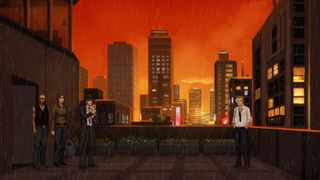
You’ve seen New York City in a thousand games before, but what makes Unavowed special is that it makes this familiar setting feel brand new. This is a dark, atmospheric, and uncanny vision of the city, with blood red skies and an otherworldly, unsettling feeling permeating every graffiti-covered street, alleyway, and rattling subway train.
I’m not normally a fan of when fantasy is married with the contemporary, but it’s so tastefully done in Unavowed that I couldn’t help but be swept up in the setting and story. It has the shadowy, mysterious feel of a film noir, but that vivid colour palette, all fiery reds and oranges, sets it apart from other games in the genre. —Andy Kelly
Edinburgh, Forza Horizon 4
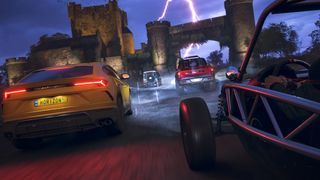
It must have insufferable to drive through Edinburgh with me, as one co-op buddy had to when we headed up north in Forza Horizon 4. I don’t get to see many of the places I’ve lived in games, aside from a few with levels set in Dubai, and certainly not facsimiles as detailed as Scotland’s very lovely capital. It’s wild. Every street made me yell and whoop like I’d just seen the most incredible thing. “I used to get stuck in traffic here every day,” I’d shout with delight. It’s not just the big monuments like Edinburgh Castle, whole chunks of the city have been recreated. It was all a bit trippy.
I lived in Edinburgh for 11 years, first moving there for university, so it’s a city absolutely full of memories—most of the first few years are a haze, admittedly. I left four years ago, so my drive through the city was a nostalgic one, full of detours and stops as I went on a catch-up tour. It’s a bit fantastical. There’s a volcano named after King Arthur a short walk from the centre of town—my old flat was right opposite it—and next to it are cliffs that look like a gargantuan wall constructed by giants. It’s a hell of a place to drive through. —Fraser Brown
E3M4: Crypt of the Flash, Dusk

Dusk is a trove of excellent and surprising level design, but my favorite might be E3M4: Crypt of the Flash for its total tonal shift. After falling from a great height into a darkened crypt, your flashlight goes out, and chances are you spent almost all your ammo thinning out the crowds of cultists in their underground village from the level prior. With almost no light and a thin arsenal, Crypt of the Flash is a tiny pocket of survival horror in an otherwise swift and violent shooter.
Viscous moans echo in the dark as you tip-toe through narrow tunnels in search of the hidden keys and buttons that’ll give you a way out. But that moaning is coming from somewhere, and the thin, pallid, puking things making that sound have some good hiding spots and don’t go down easily. It’s a jarring change of pace, but a welcome one with some genuine scares. And a secret exit. If you find a toilet (I know, a toilet in the catacombs?) hop on and flush. —James Davenport
Most Popular


